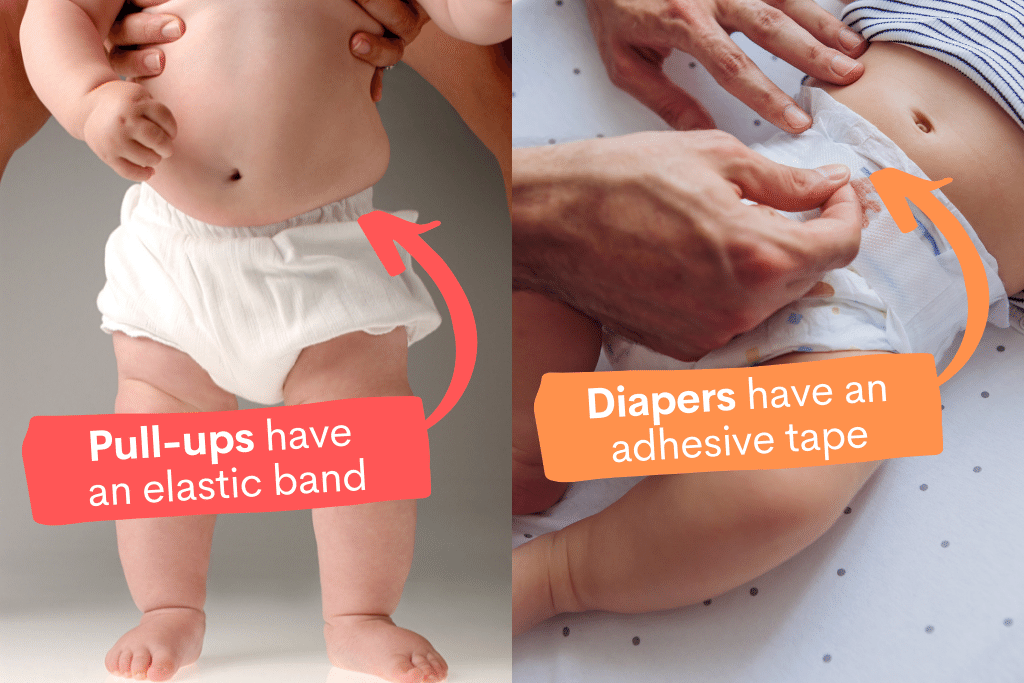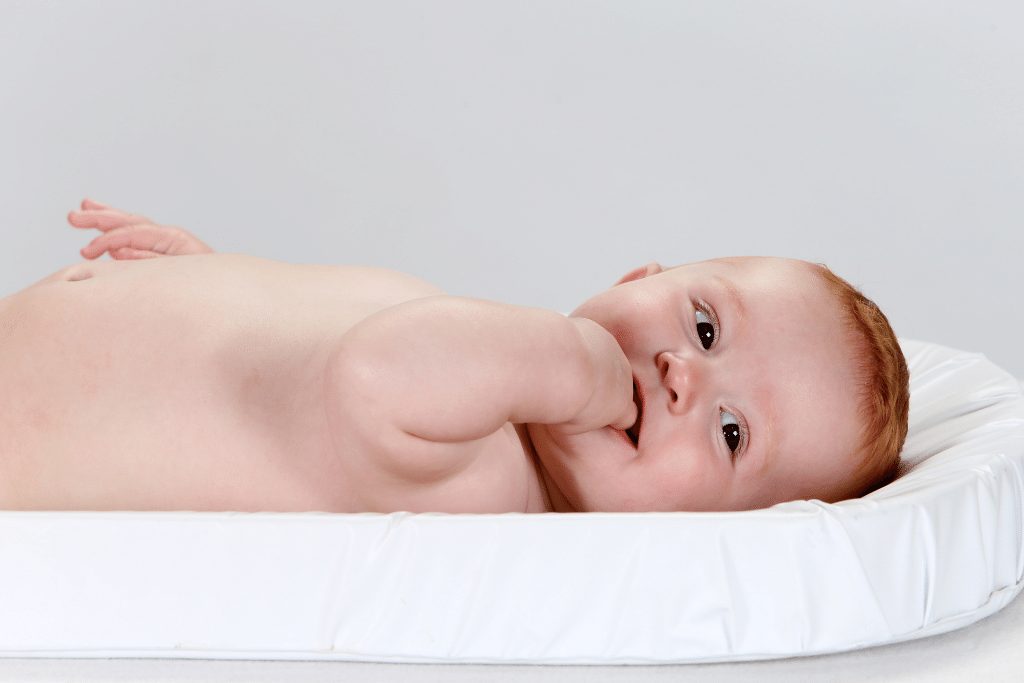Motherhood is a journey filled with choices; breastfeeding or formula, crib or bassinet, pull-ups vs. diapers – the list is endless.
Most of the time, there isn’t a wrong choice. However, one may be more suitable for you compared to the other.
In this article, we’ll look at pull-ups vs. diapers to help you understand their similarities and differences and know when to choose one over the other.
Difference Between Diapers And Pull-Ups
Diapers and pull-ups perform the same job: absorbing the waste released from your baby’s body – namely urine and poop- and preventing the baby’s clothes from getting soiled.
So what makes them different? Why is there a need for pull-ups vs. diapers discussion?
Design

The first thing that stands out between a diaper and a pull-up is their design.
The sides of a diaper are open, and it has adhesive tape tabs, which you fasten to ensure the diaper stays in place. Then, when you want to remove the diaper, you unfasten the adhesive tape.
A pull-up, on the other hand, is designed like underwear. You can put it on your baby and then pull it up so they can wear it. This is possible due to the elastic waistband it comes with. You can also choose to rip the sides apart when taking it off your baby or pull them down. So these are basically pull-up diapers.
Size
Traditional diapers are available from size 1 (for babies weighing between 8 to 14 pounds) up to size 6 (for babies weighing 35 pounds and above).
This means a baby can wear a diaper right from birth.
Most pull-ups are available from typical size 4 upwards. These are indicated as size 2T-3T (for babies weighing between 16 to 34 lbs). They then go up to 4T-5T (for babies weighing 38 lbs and above).
Therefore, you can start using pull-ups on your baby when they’re anywhere between 7 to 12 months.
Cost
You’ll spend more on buying pull-ups than diapers. However, the pull-ups vs diapers price difference isn’t significant. It also depends on the brand you go for and whether you purchase a single diaper or pull-up or buy them in bulk.
Absorbency levels
There has been a lot of debate on whether pull-ups absorb more body waste than diapers. Do pull-ups absorb like diapers?
Some brands claim that their pull-ups have the same absorbency rate as diapers or even higher. However, many parents have reported on various parenthood forums that pull-ups are prone to leaks, especially at night, and don’t absorb as much waste as diapers.
It is, therefore, safe to say that the absorbency levels of pull-ups depend on the brand you pick.
If you decide to go this route, you can opt for nighttime pull-ups because they’re made with leak guards and additional absorbent materials. As such, they adequately hold bowel movements and accommodate heavy wetting.
Diapers have an excellent absorbency rate, so you don’t have to worry about that if you choose to use them.
Pull-Ups Vs. Diapers: Pros and Cons

The pull-ups vs. diapers debate exists because they both have benefits and drawbacks. If that wasn’t the case, every parent would gravitate toward one direction.
Let’s look at the pros and cons of each.
Pros of Diapers
- Regular diapers are readily available. You can buy them from almost anywhere.
- It is less costly compared to pull-ups. Given that babies can use up to 8 to 12 diapers daily (for newborns), this is a way of saving money. The number will reduce as they get older because they won’t need many diapers.
- They are more absorbent, and you don’t have to worry about urine or poop leaking from them. It’s a great option for nighttime.
Cons of Diapers
- They’re not the most convenient to use because you have to manually stick the adhesive tape on or take it off. This also makes potty training difficult because a toddler may not be able to remove the diaper themselves to use the potty.
- It can be challenging to find diapers for older toddlers. Most of the sizes accommodate younger kids.
- It can be a bit uncomfortable since the sticky straps have to be in place and may make it difficult for a baby to easily make movements like standing up or bending.
Pros of Pull-ups
- They are available in large sizes to accommodate big toddlers who may still need them.
- Babies can freely move with them because they aren’t tight and have elastic waistbands. This is great news for active children because they’ll run around comfortably.
- It makes the process of changing a baby smoother because all you have to do is pull it up or down or tear the sides when getting it off. If your baby is not a fan of diaper changes and they usually throw a fit, you’ll get relief from using pull-ups.
- They are usually made in appealing colors and designs which attract kids. Some even have cartoon characters like SpongeBob, which causes babies to be excited to use them.
- It can be helpful during potty training, especially for older toddlers, because they can pull it down on their own and use the potty.
Cons of Pull-ups
- They’re more pricey than diapers.
- Some brands are not very absorbent, so the baby’s waste may leak during the night.
- It can make it difficult for some kids to learn to use the potty because they’re essentially similar to diapers. Some babies may not understand that they can remove them when pressed and get on the potty.
When To Use Diapers
We’ve already looked at pull-ups vs. diapers and what stands out is that they are suitable for different circumstances.
So when should you use diapers?
If you have a baby between 0 to 6 months, it’s advisable to use a diaper because pull-ups will be too big for them, given that the smallest size is 4.
Suppose your baby is a heavy wetter (their clothes or any absorbent material they use gets soaked frequently). In that case, a diaper is an excellent option because it’s designed to accommodate rich fluids. This means your baby won’t be constantly wet.
If you need something reliable for the night, then a diaper will work great because it will hold urine throughout the night, and poop won’t be leaking.
When To Use Pull-Ups
Generally, you should consider pull-ups when you’re interested in potty training. This makes the process smoother due to the advantages mentioned in the previous sections. For example, kids are attracted to them, so they won’t need much convincing to use them. A tip is to choose pull-ups with their superheroes or colors and characters you know they’ll like.
You can teach your baby to pull them up or down, which they can do when they want to use the potty. When they master this, they can apply it to their underwear. Therefore, they will know how to remove their pants and put them back on after using the potty.
When potty training, a toddler may do well during the day but have accidents at night. This is normal. Pull-ups enable them to stay dry at night and take off the pressure of peeing in the bed.
Once you’ve successfully achieved daytime training, then you can think of training them to stop wetting the bed at night.
Suppose you have a child who hates diaper change. In that case, you can use pull-ups because putting them on is easier than trying to put a diaper on them as they’re rolling or kicking. You can even change the pull-up when they’re standing instead of a diaper where they need to be lying down.
This means they’re a great option for babies learning how to crawl or walk because they tend to wiggle or run around, so getting them to be still for a diaper change can be a challenge.
Conclusion
The pull-ups vs. diapers discussion will always be there among parents. Whether you choose a diaper or pull-up, they all do the job. Some parents use diapers only and then transition straight to regular underwear, and that’s okay. Others go the diaper, then pull-ups, then underwear route, and that’s also okay. Since you’re now equipped with information on these two choices, you can make the best decision for you and your baby. It’s also important to remember that babies are different. For example, your neighbor’s baby can love pull-ups, and yours can hate them. Whichever route you take, practice patience.
Hi – I’m Alina and I am a soon to be mom going through the journey of becoming a parent. I am a writer at heart and I love sharing about pregnancy tips and other busy mom hacks.
